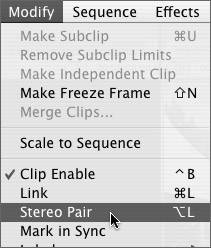High Audio Levels During Playback
Symptom #1: Loud Playback Despite Setting Optimal Levels When Shooting"I carefully set my levels in-camera to an optimal level when shooting, but when I play back in a sequence, the levels are much louder, and in some places actually clip." BackgroundUnexpectedly high audio levels during playback are usually due to the tracks having been recorded as individual mono tracks rather than as stereo-linked tracks. Since the FCP default value for Audio Format (Log and Capture > Clip Settings) is dual monoin other words, two individual mono tracksit's easy to unintentionally record stereo audio as paired mono tracks that aren't stereo-linked. And one of the unfortunate effects of doing so is that your audio levels can get boosted by waveform interference between the two tracks. Audio is composed of waves. When two sound or audio waveforms are matched, they can interfere with each other. If the waves are out of phase, meaning that the peak of one track's waves occur at the same time as the trough of the other, you get phase cancellation, and the total level of sound for both tracks decreases significantly. Phase cancellation is rare for audio captured into FCP, because the audio is captured into FCP with the same timing it had when recorded. Phase cancellation is more of an issue when recording audio in the field or when working specifically with analog audio cables. When the waveforms are in phase, the force of each wave is combined together to arrive at a new, higher audio level. If your two audio tracks are very similar, your audio levels might unexpectedly boost by +3 db or more. If your recorded audio had very high levels already, you might experience clipping that wasn't in your original recording. Stereo-linked tracks make an adjustment for this type of situation, assuming that the two tracks are a mixdown of a single sound environment and will definitely have in-phase interference between the tracks. But there's no such adjustment for dual mono audio; the two audio tracks are assumed to be different enough not to experience in-phase interference. So, when you are capturing sources such as DV through FireWire, in which the audio tracks were recorded in stereo in the camera, its very important to maintain the stereo relationship through the capture and into the clips with which you'll be editing. SolutionIf you have already captured clips and accidentally brought your stereo clips in as dual mono, you can manually "stereo-ize" any two mono clips together, provided the two clips are in a sequence and in adjacent tracks (for example, tracks 1 and 2 or tracks 3 and 4). The process is simple and entails the following steps:
|
EAN: N/A
Pages: 205
